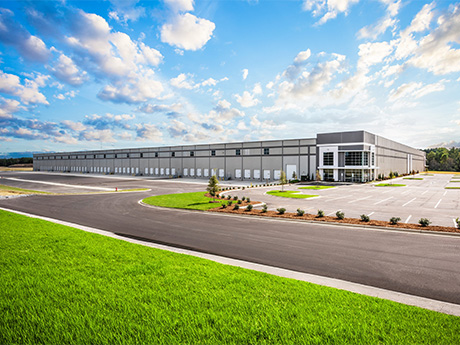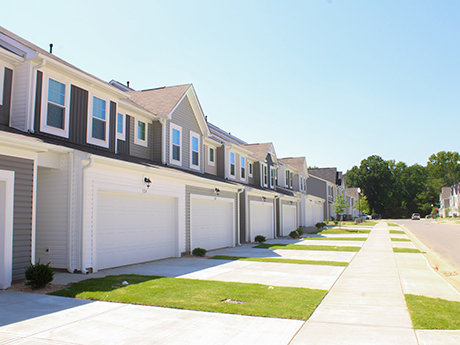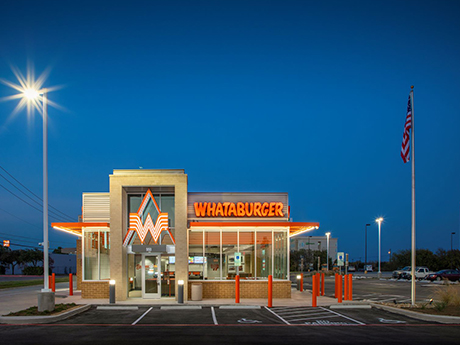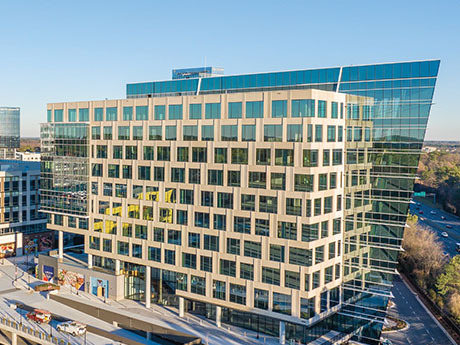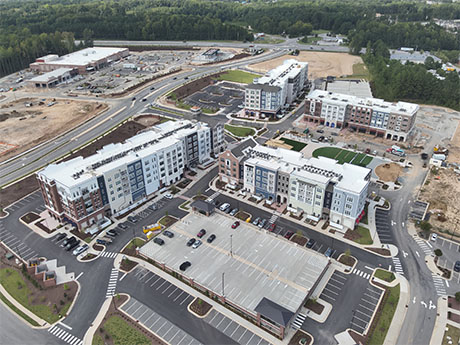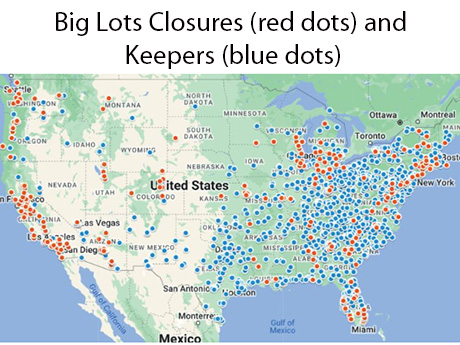More than seven months have passed since Liberation Day, where the Trump administration declared a sweeping package of tariffs for foreign trade partners and specific commodities, including steel and aluminum. Since the announcement in early April, there has been a boon in the amount of multibillion-dollar advanced manufacturing, life sciences, semiconductor and data center investment announcements around the country, with the markets along the I-85 Industrial Corridor being no exception. To name a few: Toyota has recently begun production at its $13.9 billion battery plant in Liberty, N.C.; Rivian broke ground on its $5 billion electric vehicle plant near Social Circle, Ga.; JetZero is planning to create 14,500 jobs for an aerospace manufacturing facility in Greensboro, N.C.; Eli Lilly is developing a $5 billion pharmaceutical manufacturing facility in the Richmond suburb of Goochland County, Va.; and Google is developing a trio of data centers in metro Richmond’s Chesterfield County. “We have incredible momentum bringing business back into the United States, which is going to drive industrial growth, particularly in the Southeast,” says Jim Anthony, CEO and founder of APG Companies. “We’re not unionized, we have lower taxes, fewer regulations and lower cost of energy, which is huge factor in site …
Market Reports
AlabamaGeorgiaIndustrialMarket ReportsNorth CarolinaSouth CarolinaSoutheastSoutheast Market ReportsVirginia
The momentum in Charlotte’s office market continues into 2025, showcasing a strong first quarter marked by positive net absorption and a surge in multi-market tenant prospects. We are currently seeing three times as many expansions as downsizing among tenants, indicating a psychological shift among decision-makers across various industries. Despite some large vacancies affecting the overall market rate, the narrative on the ground in Charlotte is one of optimism and urgency. A few factors contribute to this trend, including companies are increasingly bringing employees back to the office, and those that overcorrected their space needs post-pandemic are reassessing their strategies. Particularly interesting is the demand for Class A office space in Charlotte, a thriving Sun Belt market. The most sought-after buildings in prime locations are nearly full, leading to reduced concessions and rising rents. This stands in stark contrast to reports of distressed assets negatively impacting modern office investments. Furthermore, the number of quality subleases are limited, and new construction is expected to come to a halt soon, particularly as remaining spaces in 110 East and Legacy Union are leased, most likely by year-end. If last year is any indication of a fundamental positive shift in the office sector, we can …
The Charlotte industrial market continues to display resilience in 2025, navigating a national slowdown with more stability than a lot of other markets. While economic headwinds and record supply volumes have created challenges nationally, Charlotte’s fundamentals remain anchored by consistent tenant demand, especially for Class A space under 200,000 square feet. As vacancy stabilizes and rent spreads narrow between asset classes, a clear flight to quality trend is reshaping how tenants prioritize space and make leasing decisions throughout the region. In first-quarter 2025, Charlotte recorded just over 1 million square feet of net absorption, maintaining positive momentum while absorbing the wave of speculative deliveries over the past several years. Fifty-six percent of all leases signed in the first quarter were for Class A space — the highest percentage recorded for Class A product since 2016, according to research from Avison Young. This stands out in light of the significant volume of new construction deliveries that have come on line vacant in recent years. With the rent premium between Class A and B product narrowing, tenants are increasingly seizing the opportunity to relocate into newer, more efficient facilities. The tenant-in-the-market (TIM) pipeline tells a compelling story. More than 12 million square …
Charlotte’s multifamily market is turning a corner after a once-in-a-generation supply wave that introduced 19,000 new apartments into the metro area in 2024. While rent growth will be muted for most of the year as the market continues to absorb the new supply, the dynamic will shift toward the end of 2025, putting landlords back in the driver’s seat. Record-low new apartment starts this year, combined with steady population growth and an economic climate that favors renting over owning will boost leasing activity in the second half of the year — and may even produce rent growth for the first time since 2022. Fundamentals in play Like many other Sun Belt cities, Charlotte has been on a joyride of growth stemming from in-migration since the COVID-19 pandemic. The city’s population expanded 2.2 percent between 2023 and 2024, making it one of the fastest-growing markets in the Southeast. Another 56,000 new residents are expected to move in by the end of the year, according to research from Berkadia. The long-term forecast for population growth is even rosier: the Charlotte Regional Business Alliance forecasts the metro population will surge by 50 percent over the next 25 years, driving demand for housing. Tariff …
Charlotte: “The Queen City” named after Queen Charlotte, wife of George III, has been on a tear post-COVID with new and expanding retail concepts. Vacancy rates have hovered under 4 percent the last few years, with little signs of changing , according to research from Institutional Property Advisors (IPA). Much of that vacancy has occurred in less desirable markets, or in junior and big-box bankruptcies (JOANN, Big Lots, Party City, etc.) that are being snatched up as quickly as they become vacant. Tenants are desperate and clamoring for new locations to keep up with the strong residential growth (24,000+ new residents in the city limits in 2024 and 46,000 in the CSA), making charlotte the 14th largest city in the country, and 19th-largest CSA in terms of overall population. This factor combined with unemployment hovering in the low 4 percent range, plus household income growth has called for desperate measures to ID new space or weakness in the market. We as local experts have seen a slight uptick, over the past 12 months, in some “shadow inventory.” This occurring when an existing retailer or restaurant might be struggling with sales, or in partial default, and the landlord has the opportunity …
Raleigh-Durham’s office market entered the year on a positive note as 2024 ended strong. Vacancy was largely flat in the fourth quarter, net absorption neared 300,000 square feet and move-outs were sparse. After years of uncertainty and short-term renewals dominating the landscape, companies are now committing to longer leases. Clarity around business drivers, a growing labor pool and new market entrants are all contributing factors to this decisive turn. Firms are confidently making long-term real estate decisions, bringing lease terms back to the five- to 10-year range. While the vibrancy of the pre-pandemic era has not fully returned, data shows a steady recovery throughout 2024, and 2025 is poised to bring even stronger growth. In 2024, Raleigh-Durham welcomed several notable commitments from companies establishing a foothold in the market, like Jewelers Mutual, JTL and Amgen. Leasing activity stayed strong through the fourth quarter, supporting the net absorption of nearly 160,000 square feet of office space over the course of the year. Rents have seen some downward corrections overall, but well-located, highly amenitized assets have retained rent stability. Recent recommitments from major companies like Nutanix and Hitachi highlight the area’s enduring appeal. Vacancy closed out December at 17.3 percent but was …
The secret is getting out about Apex, a western suburb of Raleigh that also lies 20 miles south of Chapel Hill. In 2018, Realtor.com ranked the city as the No. 1 fastest growing suburb in the United States. This was aided by the master planning of local homebuilder/developer ExperienceOne Homes, which debuted its large-scale Sweetwater residential development in 2016. The allure of Apex didn’t stop there as the local schools within the Wake County Public School System have long been considered top-notch. As more and more families moved to the once-sleepy town, the need for community-serving retail became apparent. And not just any sprawling shopping center would suffice. Retail Strategies of N.C. Inc., on behalf of development partner The Kalikow Group, a multifamily and mixed-use development firm based in Westbury, New York, and the aforementioned ExperienceOne, set out to create a sense of place that would resemble village towns in Northeast states such as Maine and Massachusetts. What all of these hamlets have in common is they are built up over decades around a town center, thus the idea of Sweetwater Town Center was established. East Side The “hard part” was essentially in the rearview mirror as ExperienceOne had already …
For all Top 50 NMHC third-party management firms, the subject of managing rising operating costs is a topic that has come to be front and center in many recent client conversations. “As 2025 budget discussions were taking center stage toward the end of 2024, our clients increasingly highlighted the issues of rising operating costs,” says Lisa Narducci-Nix, director of business development at Drucker + Falk. “This trend”, she adds, “underscores our need for strategic planning and cost management to navigate the continued challenges ahead.” The multifamily sector is facing unprecedented headwinds as operating costs continue to rise, driven by factors ranging from inflation and labor shortages to increased insurance premiums and energy expenses. As a result, multifamily operators are working to find ways to maintain profitability while providing quality living spaces for their residents. “In this challenging environment, it is clear to us that adapting to these rising costs will require a multifaceted approach — one that blends innovation, strategic marketing, operational efficiency and technological adoption,” says Narducci-Nix. Challenges of rising costs Across its 11-state footprint spanning over 42,000 units, Drucker + Falk has seen operating costs for many of its managed assets surge in recent years. The supply chain …
Multifamily Supply Hits Record High in Raleigh-Durham as Development Pipeline Empties
by John Nelson
This year, multifamily housing starts nationally are on pace to hit their lowest levels since 2014, a period marked by the national economy’s gradual recovery from the Great Financial Crisis. Year to date, multifamily deliveries have exceeded starts by 218,500 units, creating a substantial shortfall that signals a significantly reduced apartment supply by 2026. The same trend is taking effect in Raleigh-Durham, where completions exceeded starts by 4,935 units. This is a key consideration for most apartment investment strategies today, explaining why many buyers are willing to accept Year 1 challenges such as softness or negative leverage. As the current supply wave peaks in the Triangle, the future pipeline of multifamily construction is shaping up quite different. Of the identified units that are scheduled for delivery in 2024, nearly 42 percent of units have been delivered as of this writing. Of the approximately 18,600 apartments currently under construction across the Triangle, 13,343 of those are expected to be delivered by the end of third-quarter 2025, with a majority in Central and Southeast Raleigh. However, new activity has slowed significantly — inventory growth by 2027 is projected to drop by more than 85 percent, plummeting to a 3.6 percent rate compared …
As someone who has closely observed retail trends in the Southeastern United States for decades, I’ve witnessed the inevitable ebb and flow of the industry. From periods of rapid expansion to challenging market corrections, and of course, global pandemics that disrupted every sector of real estate, it often feels as though I’ve ‘seen it all.’ Once again, I find myself watching the market adjust, particularly among big-box retailers, in high-growth areas like Raleigh. This ongoing shift signals both challenges and opportunities, reminding me of the resilience and adaptability required to thrive in this dynamic environment. When news broke in September that Big Lots Inc. had filed for Chapter 11 bankruptcy protection and that it would be closing more than 300 stores across the country, it wasn’t all that shocking, given the sheer number of Big Lots that one comes across just driving across their own towns. The Big Lots announcement follows similar moves by companies such as rue21, Express, The Body Shop, 99 Cents Only Stores, LL Flooring, Conn’s, and Red Lobster. Retailers like Rite Aid and Bed Bath & Beyond, which filed for bankruptcy last year, have closed hundreds of stores, causing vacancies in the retail real estate market. …
Newer Posts


